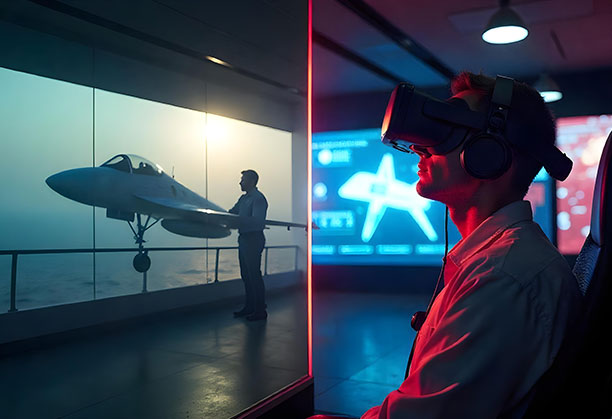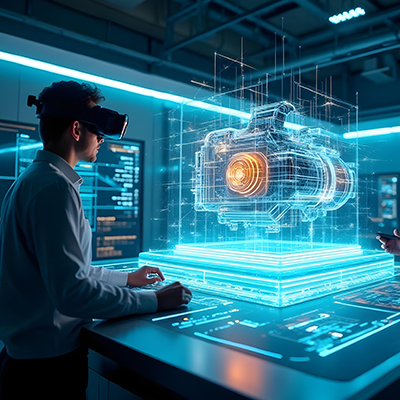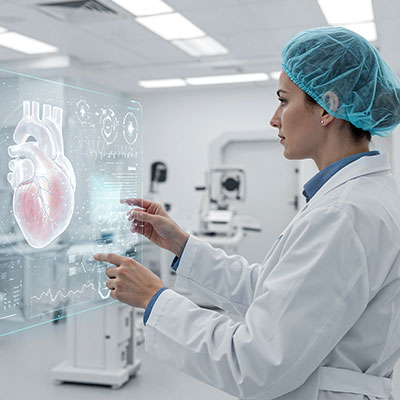In the perilous environment of airport operations, the relatively simple act of jet bridge docking requires extreme precision. As aviation evolves, virtual reality (VR) simulations have emerged as game changers in ground staff training, providing immersive, risk-free environments that mirror real-world challenges while reducing operating risks and costs.
Why Precision in Jet Bridge Docking Matters
The alignment of a jet bridge with an aircraft’s door represents one of the most critical yet underappreciated moments in the passenger journey. This precision operation demands millimeter-level accuracy, with consequences that extend far beyond mere convenience.
Proper jet bridge docking is primarily a safety concern. When a jet bridge fails to line properly with an airplane door, dangerous gaps form, posing major risks to passengers and crew during boarding and deboarding. These gaps not only represent a trip hazard, but they can also expose travelers to extreme weather conditions or potentially fatal falls.
From an operational standpoint, the stakes are as high. In a sector where minutes immediately convert into profit margins, the effectiveness of jet bridge operations can make or break an airline’s schedule adherence. A delay in appropriate alignment can cause a chain reaction of operational issues, including delayed departures, missed connections, and compromised passenger experiences.
Perhaps most critically, the structural integrity of aircraft themselves depends on precise docking procedures. Modern commercial aircraft represent investments worth hundreds of millions of dollars, with exterior components designed to exacting specifications. The kinematic systems of advanced jet bridges, such as the HÜBNER system, are specifically engineered to exert minimal pressure on aircraft fuselages while maintaining a weather-tight seal. Incorrect docking can damage these expensive assets, leading to:
- Aircraft being taken out of service for repairs
- Significant maintenance costs
- Schedule disruptions across multiple routes
- Potential regulatory implications
As passenger volumes grow globally and airlines operate with increasingly tight margins, precision in these seemingly routine operations has never been more critical.
The Shortcomings of Traditional Training Methods
Traditional approaches to training jet bridge operators have long suffered from fundamental limitations that compromise both safety and efficiency. These conventional methods create a problematic training environment that fails to prepare personnel for the complexities of real-world operations adequately.

Risk Exposure
The most glaring shortcoming in traditional training approaches is the unavoidable risk exposure. Learning in real operational environments places both multi-million dollar aircraft and actual personnel in potential danger. A trainee’s miscalculation during docking can result in direct damage to the aircraft fuselage or doors, potential injury to ground personnel, disruption to flight schedules affecting hundreds of passengers, and costly repairs and downtime for both aircraft and jet bridges.
Logistical and Financial Burdens
Traditional training creates substantial logistical challenges that extend beyond safety concerns. Operational equipment must be taken out of service during training sessions, reducing airport capacity. Training must be scheduled around flight operations, often resulting in suboptimal learning times and rushed sessions. The cost of dedicating actual aircraft and jet bridges for training purposes represents a significant financial burden. Additionally, instructor availability must align with equipment availability, creating scheduling complexity.
Limited Scenario Exposure
Conventional training methods can only expose trainees to a narrow range of scenarios:
- Training typically occurs in favorable weather conditions rather than preparing operators for challenging situations
- Emergency scenarios cannot be realistically simulated without creating actual emergencies
- Rare aircraft types or unusual configurations may not be available for practice
- Night operations training requires scheduling during actual nighttime hours, limiting flexibility
Feedback Limitations
The instructional quality of traditional training also suffers from structural limitations:
- Immediate feedback may be compromised by the instructor’s need to focus on safety
- Repeating specific maneuvers for reinforcement disrupts operational schedules
- Documentation of performance metrics is typically manual and subjective
- Consistent evaluation standards are difficult to maintain across different instructors
These fundamental shortcomings create a training paradox: the high-stakes nature of jet bridge operations demands perfect execution, yet traditional training methods cannot provide the repetition, variety, and feedback necessary to develop this precision without creating operational risks.
How VR Solves These Training Challenges
Virtual Reality simulations represent a paradigm shift in jet bridge operator training, addressing the fundamental limitations of conventional approaches while introducing revolutionary new capabilities. The transformative impact of VR technology creates a training environment that is simultaneously safer, more comprehensive, and more effective.
Eliminating Operational Risk While Enhancing Learning
VR simulations create a zero-consequence environment where mistakes become valuable learning opportunities rather than costly accidents. This fundamental shift delivers multiple benefits. Trainees can experience the full consequences of errors without damage or injury. Learning can progress at the optimal pace for each individual without pressure to rush. Instructors can focus entirely on teaching rather than safety management. High-risk scenarios can be explored thoroughly without operational concerns.
Cost-Effective Scaling of Training Operations
The economics of VR training create compelling advantages for aviation operations. No physical equipment is taken out of service, maintaining full operational capacity. Training sessions can be conducted in parallel, allowing multiple operators to train simultaneously. Hardware investments are orders of magnitude less expensive than dedicating actual jet bridges and aircraft. Maintenance and operational costs associated with training on physical equipment are eliminated. Training can occur regardless of actual flight schedules or weather conditions.
Comprehensive Scenario Exposure
Perhaps most powerfully, VR simulations expand the range of training experiences far beyond what conventional methods could ever provide. Operators can experience docking procedures with rare aircraft types that may visit an airport only occasionally. Weather conditions, from intense storms to low visibility, can be simulated on demand. Emergency scenarios such as power failures or mechanical malfunctions can be practiced repeatedly. Different times of day and lighting conditions can be experienced regardless of the actual time of training. Unusual situations like irregular aircraft parking positions can be simulated.
Advanced Feedback Mechanisms
The digital nature of VR simulations enables sophisticated feedback that elevates the learning experience:
- AI-powered real-time guidance provides immediate correction during operations
- Performance metrics are automatically captured with precise measurements
- Trainees can review their own performance from multiple perspectives after completion
- Progress can be tracked objectively across sessions with detailed analytics
Instructors can focus on higher-level skills while the system addresses basic procedural elements
By addressing each major limitation of traditional training while introducing entirely new capabilities, VR simulations don’t merely improve jet bridge operator training—they fundamentally transform it into a more effective, accessible, and comprehensive preparation for these critical aviation roles.
Key Features of an Effective VR Jet Bridge Training Module
An exceptional VR training system for jet bridge operations integrates multiple sophisticated elements to create an experience that not only replicates reality but enhances the learning process through advanced technology. The most effective systems incorporate the following critical components:
Physics-Based Realism
The foundation of effective training lies in achieving simulation fidelity that accurately mirrors real-world physics:
- Articulated Joint Modeling: Advanced simulations replicate the precise articulation of telescoping jet bridge sections using inverse kinematics (IK) systems that calculate realistic movement constraints and motion patterns.
- Weight and Momentum Simulation: Using Unity’s PhysX engine, effective modules calculate the mass, inertia, and momentum of the jet bridge during operation, replicating the feeling of controlling a multi-ton piece of equipment.
- Collision Detection and Response: Sophisticated collision systems detect contact between the jet bridge and aircraft with millimeter precision, triggering appropriate visual and haptic feedback.
- Weather Effects on Operations: Physics calculations account for environmental factors like wind resistance that affect jet bridge movement during adverse conditions.
Comprehensive Scenario Library
Effective training modules provide extensive scenario variations to prepare operators for any situation:
- Aircraft Type Diversity: Complete training systems include models of all common commercial aircraft types with accurate door positions and heights, including:
- Narrow-body aircraft (A320 family, Boeing 737 variants),
- Wide-body aircraft (Boeing 777/787, Airbus A330/A350/A380)
- Regional jets and less common configurations.
- Operational Challenges: Scenarios incorporate realistic complications such as:
- Aircraft parked at non-standard angles,
- Ground equipment obstructions,
- Communication delays
- Time pressure situations
- Environmental Variations: Comprehensive modules simulate operations in:
- Heavy rain, snow, and fog conditions
- High wind scenarios
- Extreme temperature conditions
- Night operations with limited visibility
Intelligent Guidance Systems
Advanced AI systems transform the training experience by providing adaptive instruction:
- Contextual Voice Guidance: Natural language processing enables the system to provide verbal instructions that adapt to the trainee’s actions and progress.
- Progressive Assistance Levels: AI systems adjust the level of guidance based on trainee proficiency, gradually reducing support as skills develop.
- Error Detection and Correction: Machine learning algorithms identify patterns in trainee mistakes and provide targeted remediation for specific weaknesses.
- Performance Prediction: Advanced systems can anticipate potential errors based on the current trajectory and provide preemptive guidance.
Multi-User Collaborative Training
Effective VR modules incorporate social learning aspects that enhance the training experience:
- Instructor Presence: Virtual environments allow instructors to join simulations in real-time, observing from any angle and providing live guidance.
- Peer Observation: Other trainees can observe operations from multiple perspectives, learning from both successes and mistakes.
- Role-Playing Scenarios: Comprehensive systems allow trainees to experience both operator and support roles to understand team dynamics.
- Performance Competitions: Gamification elements enable friendly competition based on precision metrics and completion times.
Analytics and Performance Tracking
Data-driven assessment transforms subjective evaluation into objective measurement:
- Precision Metrics: Systems track millimeter-level accuracy in final positioning, approach speed, and alignment angles.
- Efficiency Assessment: Time-to-completion metrics evaluate operational efficiency while maintaining safety standards.
- Progress Visualization: Dashboards display improvement over time across multiple performance dimensions.
- Certification Tracking: Integration with training management systems enables automatic documentation of completed modules and demonstrated competencies.
These sophisticated features work in concert to create training experiences that not only prepare operators for standard procedures but develop advanced situational awareness and decision-making skills that transfer directly to improved operational performance.
Real-World Impact of VR Training in Aviation
The integration of Virtual Reality into jet bridge training programs has delivered measurable improvements across multiple performance dimensions. Far from theoretical benefits, these implementations have transformed operational realities for airlines and airports worldwide.
Quantifiable Safety Improvements
Safety metrics demonstrate the concrete impact of VR training implementations:
- Reduced Incident Rates: Fraport Ground Services reported a 78% reduction in minor jet bridge incidents following the implementation of comprehensive VR training programs for all operators.
- Near-Miss Decline: Advanced analytics tracking near-miss events showed a 62% decrease at major hub airports where VR training had been fully deployed for at least six months.
- Trainee Confidence: Surveys revealed that 91% of operators who completed VR training reported higher confidence in handling emergency situations compared to those trained through conventional methods.
- Knowledge Retention: Performance assessments conducted 6 months after training completion showed 42% higher knowledge retention among VR-trained personnel versus traditionally trained operators.
Operational Efficiency Gains
The impact extends beyond safety to core operational metrics:
- Reduced Connection Times: Airlines implementing VR training programs reported average reductions of 1.2 minutes in gate-to-gate times across domestic operations, with cumulative schedule improvements measured in thousands of hours annually.
- Training Completion Rates: Training departments achieved 34% faster qualification of new operators, allowing more rapid deployment of fully trained personnel during peak periods.
- Scheduling Flexibility: The elimination of equipment-dependent training allowed 24/7 qualification programs, enabling more efficient staff utilization and reducing overtime costs by approximately 28%.
- Standardization Improvements: Performance variation between operators decreased by 47%, leading to more predictable turnaround times and improved schedule reliability.
Cost-Benefit Analysis
| Category | Impact / Savings | Details |
| Equipment Damage Reduction | €3.2 million annually | Saved on maintenance and repair costs for aircraft and jet bridges at a major international hub. |
| Training Cost Comparison | 62% lower per-operator cost | Compared to traditional methods; initial VR investment typically recouped within 14 months. |
| Operational Continuity | €780,000 annually | Preserved operational capacity by avoiding equipment downtime during training at a mid-sized European airport. |
| Insurance Premium Effects | 8–12% reduction | Achieved by major ground handling operations after adopting comprehensive VR training programs. |
Case Studies in Implementation Excellence
KLM Royal Dutch Airlines
KLM Royal Dutch Airlines has integrated VR into its training programs for various operations, including jet bridge docking, fire safety, and pushback training. These programs allow employees to train in realistic virtual environments without needing physical aircraft or equipment. KLM partnered with educational institutions like Albeda Rotterdam, The Hague Airport College, and Deltion College in Zwolle to develop VR modules. Their VR implementation enables flexible and unlimited training for pilots and ground staff, allowing them to practice Standard Operating Procedures (SOPs) virtually. The Fire Safety module simulates lifelike scenarios, including smoke alarms and passenger reactions, to enhance emergency preparedness.
Singapore Changi Airport
Singapore Changi Airport introduced a VR aerobridge simulator in 2019 to improve operator training. The simulator reduces the need for physical aerobridge use during training by 25%, freeing facilities for operational use. It provides hands-on experience in connecting aerobridges to aircraft and handling various scenarios like rainy weather or different plane types. The system was developed collaboratively with Aviation Virtual.
Ready to minimize docking errors and improve crew efficiency?
Juego neXR: Elevating Aviation Training Through VR
Juego neXR has revolutionized aviation training with its cutting-edge VR solutions that combine unprecedented technical sophistication with practical implementation strategies. The company’s proprietary physics engine delivers hyper-realistic jet bridge operation simulation, while its advanced weather effect algorithms create immersive environmental challenges that prepare operators for any condition. Juego neXR has established itself as the premier provider of VR training solutions for United Airlines’ ground operations, focusing specifically on the unique challenges of jet bridge operations.
Conclusion
VR training for jet bridge operations represents not merely an improvement but a paradigm shift in aviation safety and efficiency. The technology has matured beyond experimental status to become an essential component of modern ground operations preparation, delivering measurable improvements in incident reduction, operational efficiency, and cost management. As leading airlines and airports continue to report compelling ROI figures and performance gains, the question is no longer whether to implement VR training but how quickly organizations can integrate these solutions to remain competitive in an industry where perfect execution is the only acceptable standard.
Frequently Asked Questions (FAQs)
VR training typically demonstrates a 60-70% cost reduction compared to traditional methods when accounting for all factors. While the initial technology investment appears significant, the elimination of aircraft and equipment downtime, reduced instructor hours per trainee, and lower facility requirements result in substantial savings. Additionally, the accelerated training timeline allows faster deployment of qualified personnel, creating operational cost benefits beyond direct training expenses.
Effective implementation requires:
- VR Headsets: Commercial-grade headsets with 6DOF (six degrees of freedom) tracking
- Computing Hardware: VR-capable computers with dedicated graphics processing
- Optional Components: Haptic feedback controllers for enhanced realism
- Networking Infrastructure: For multi-user training scenarios
Many operations partner with training technology providers who supply complete hardware solutions as part of implementation packages.
Implementation timelines vary based on organizational readiness and scope, but typically follow this pattern:
- Planning and Assessment: 2-4 weeks
- Technology Deployment: 2-3 weeks
- Instructor Training: 1-2 weeks
- Initial Trainee Cohort: 2-4 weeks
- Full Operational Integration: 2-3 months
Leading providers like Juego neXR have developed streamlined implementation methodologies that can accelerate this timeline for organizations requiring rapid deployment.
While VR provides comprehensive preparation, most effective programs incorporate a final hands-on validation phase where trainees demonstrate proficiency on actual equipment. However, this phase typically requires only 10-20% of the time needed in traditional programs since trainees arrive with established procedural competence. The optimal approach combines extensive VR training with brief hands-on validation to confirm skill transfer.
Contrary to common concerns about technology adaptation, aviation personnel typically adapt quickly to VR environments. Studies indicate:
- 90% of trainees achieve comfort with VR interfaces within 15-20 minutes
- Age has not proven to be a significant factor in adaptation rates
- Previous technology experience shows only minimal correlation with VR learning curves
- The immersive nature of the training typically overcomes initial hesitation
Most implementations incorporate a brief orientation module specifically designed to familiarize trainees with the VR environment before beginning operational training.
VR training enables more objective and comprehensive evaluation than traditional methods through:
- Automated Metrics: Precise measurements of positioning accuracy, operation smoothness, and procedure adherence
- Scenario Completion Rates: Success percentages across increasingly challenging situations
- Consistency Analysis: Performance variation across multiple attempts
- Time-Based Efficiency: Completion time measurements while maintaining safety parameters
- Error Pattern Identification: Analysis of recurring mistakes requiring remediation
These objective measurements create more reliable certification standards while identifying specific improvement opportunities for each trainee.
Revolutionize the future of business with Juego neXR
Table of Contents
- Why Precision in Jet Bridge Docking Matters
- The Shortcomings of Traditional Training Methods
- How VR Solves These Training Challenges
- Key Features of an Effective VR Jet Bridge Training Module
- Real-World Impact of VR Training in Aviation
- Juego neXR: Elevating Aviation Training Through VR
- Conclusion
- Frequently Asked Questions (FAQs)
Related Posts
Share this Article:
Our Offices

India
Bangalore
GR Grand Plaza, 2nd Floor, JP Nagar, 6th Phase, Bangalore – 560 078

KSA
Jeddah
St Idris Square, 4036 Helmi Koutbi, Al Zahra, Jeddah 23425, Saudi Arabia
Follow Us On:
© 2025 Juego neXR. All Rights Reserved.




